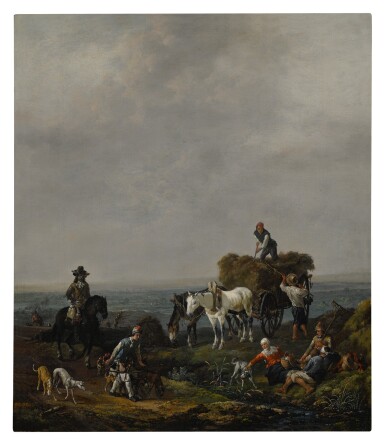
Johannes Lingelbach
Falconers on a path with harvesters loading hay onto a wagon nearby, a valley beyond, at dusk
Lot Closed
January 30, 03:31 PM GMT
Estimate
70,000 - 90,000 USD
Lot Details
Description
Johannes Lingelbach
Frankfurt am Main 1622 - 1674 Amsterdam
Falconers on a path with harvesters loading hay onto a wagon nearby, a valley beyond, at dusk
signed and dated lower center: Jlingelbach/1659
oil on canvas
canvas: 20 1/3 by 17 1/4 in.; 51.5 by 43.6 cm.
framed: 26 3/4 by 23 3/4 in.; 67.9 by 60.3 cm.
With D. Katz, Dieren, circa 1955;
E. Ongering, Bilthoven, 1958;
Anonymous sale, Amsterdam, Christie’s, 11 May 1994, lot 169 (sold for 247.250 guilders);
With Richard Green, London;
From whom acquired by a private collector, England;
From whom acquired by the present owner.
Although Johannes Lingelbach was born in Germany, his family moved to Amsterdam by the time he was twelve years old, and he probably received his artistic training there. He may have visited France, and he was certainly in Rome from 1647 to 1650. However, the artist spent the rest of his life in Amsterdam after 1653. While Pieter van Laer’s (circa 1592–1642) influence was paramount on Lingelbach during his years in Italy, the Haarlem painter Philips Wouwermans (1619–1668) seems to have inspired him most after his return to Holland in the early 1650s. After Lingelbach’s return he was increasingly influenced by the latter's landscapes with figures at work and horses, themes exemplified in the present painting. In many contemporary accounts, Lingelbach is mentioned as a pupil of Wouwermans. This presumption is based on Lingelbach’s paintings from the late 1650s and 1660s.1 However, it is also possible that Lingelbach absorbed this influence through Wouwerman’s fellow-townsmen Jan Wijnants (circa 1630–1684), who moved from Haarlem to Amsterdam in 1659. From 1660 on, Lingelbach contributed staffage to Wijnants’ paintings.2The present harvesting scene, executed in 1659, is a work of the artist’s maturity and has strong affinities Wouwermans classic horse landscapes. The scene takes place at dusk, the last few rays of sun gilding the grasses in the foreground and gleaming on the white horse’s flanks. A hay cart, drawn by two horses, has halted by a stream, while one peasant hands over hay with a pitchfork to another standing atop the pile of hay in the cart. To the right, a peasant family sit and eat by the stream, while to the left a falconer and a rider returning from the hunt make their way along the stream towards the viewer. The falconer is carrying a hoop of hooded falcons and is followed by four greyhounds. Immediately behind the grassy outcrop of the foreground of the painting stretches a hazy, distant valley, the figures forming a repoussoir against the valley and the sky. A very similar composition by Wouwerman with the same subject, and an absence of a middle ground and a high horizon, can be seen in Peasants in the Field: Hay Harvest in the Dulwich Picture Gallery in London.
There are several repetitions of the subject in important museum collections. One variation on the theme, and similar in size though horizontal in format, is Lingelbach’s Landscape with Farmers at Rest in the collection of The Mauritshuis in The Hague. A horizontal example by the artist and dated 1664 is in the National Gallery, London. The third comparable example to the present painting, The Grass Crop is in the collection of the Staatliches Museum in Schwerin.
1. C. Burger-Wegener, Johannes Lingelbach, Berlin 1976, pp. 124, 193, note 282, refers to Scheltema 1853; Wurzbach 1910; Zülch 1935; HdG II, S.658.
2. Burger-Wegener 1976, p. 126.
